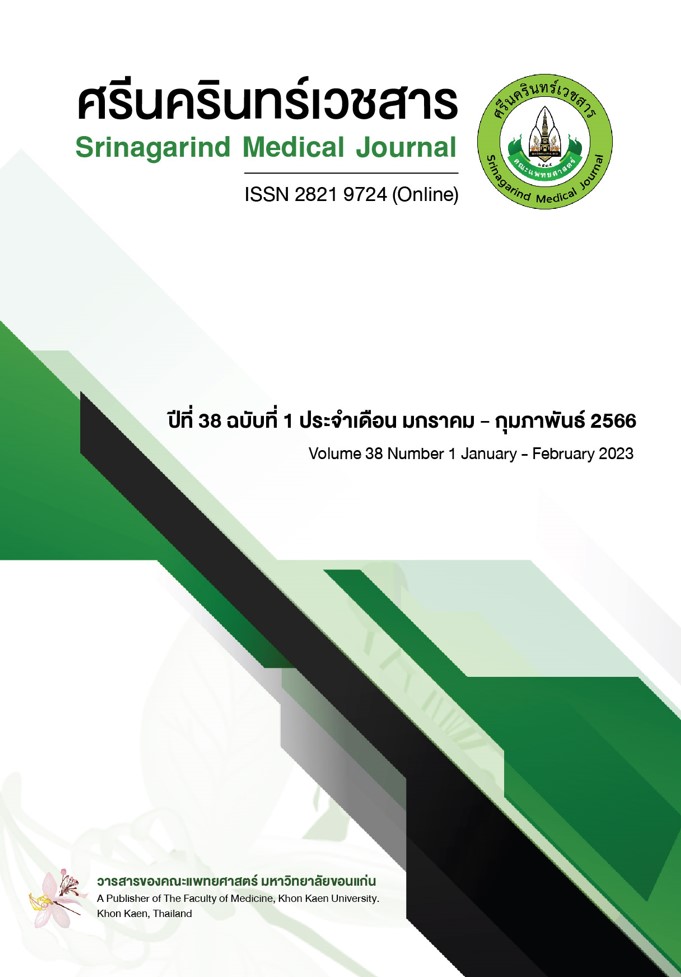ผลกระทบของการระบาดของโควิด-19 ต่อการบริจาคโลหิตของคลังเลือดกลาง คณะแพทยศาสตร์ มหาวิทยาลัยขอนแก่น
Abstract
Impact of COVID-19 Pandemic on Blood Donation in Blood Transfusion Center, Faculty of Medicine, Khon Kaen University
Poonsup Sripara*, Namrin Boonmawongsa, Boonsong Benjangkaprasert, Thanet Thanukarn, Nicha Phumiyot, Kriangsak Jenwitheesuk
Blood Transfusion Center, Faculty of Medicine, Khon Kaen University, Khon Kaen 40002, Thailand
หลักการและวัตถุประสงค์: โลหิตเป็นสิ่งสำคัญที่ช่วยรักษาชีวิตผู้ป่วย โลหิตที่ใช้ในการรักษาพยาบาลและการผ่าตัดผู้ป่วยได้มาจากการบริจาคทั้งสิ้น การแพร่ระบาดของ COVID-19 ส่งผลกระทบอย่างหนักต่อการดำเนินชีวิตของผู้บริจาคโลหิตและประชาชน ผู้คนกลัวการติดเชื้อ ต้องปฏิบัติตามมาตรการทางสาธารณสุขอย่างเคร่งครัด และงดการเดินทางติดต่อกัน ทำให้ปริมาณการบริจาคโลหิตลดต่ำลง มีโลหิตไม่เพียงพอ เกิดวิกฤติขาดแคลนโลหิตทั่วประเทศ ผู้วิจัยจึงต้องการศึกษาถึงผลกระทบและแนวทางการจัดหาโลหิต ของคลังเลือดกลาง คณะแพทยศาสตร์ มหาวิทยาลัยขอนแก่น ในช่วงที่มีการระบาดของ COVID-19 ในปี พ.ศ. 2563-2564
วิธีการศึกษา: เป็นการศึกษาข้อมูลการบริจาคโลหิตย้อนหลังระหว่างปี พ.ศ. 2562-2564 โดยใช้ค่าสถิติเชิงพรรณนาและ chi-square test
ผลการศึกษา: ปี พ.ศ. 2562-2564 มีการบริจาคโลหิตจำนวน 29,861, 29,862 และ 28,855 ยูนิต ตามลำดับ บริจาคภายในสถานที่จำนวน 20,206, 18,728 และ 18,782 ยูนิต (ร้อยละ67.67, 62.72 และ 65.09) ตามลำดับ ออกหน่วยเคลื่อนที่จำนวน 9,655, 11,134 และ 10,073 ยูนิต (ร้อยละ32.33, 37.28 และ 34.91) ตามลำดับ โดยแบ่งเป็นการออกหน่วยขนาดใหญ่ (ครั้งละ100-300 ยูนิต) 61, 67 และ 66 ครั้ง (ร้อยละ 100.00, 77.91 และ 55.00) ตามลำดับ และขนาดเล็ก (ครั้งละ 20-50 ยูนิต) จำนวน 0, 19 และ 54 ครั้ง (ร้อยละ 0, 22.09 และ 45.00) ตามลำดับ เป็นการบริจาคโดยไม่หวังสิ่งตอบแทน จำนวน 27,567, 27,420 และ 23,484 ยูนิต (ร้อยละ99.66, 98.96 และ 86.46) ตามลำดับ และบริจาคทดแทนจากญาติ จำนวน 95, 289 และ 3,678 ยูนิต (ร้อยละ0.34, 1.04 และ 13.54) ตามลำดับ เมื่อเปรียบเทียบสัดส่วนของโลหิตบริจาค ภายในสถานที่กับหน่วยเคลื่อนที่ หน่วยขนาดใหญ่กับขนาดเล็ก และชนิดของการบริจาคระหว่างปี พ.ศ. 2562-2564 พบว่าแต่ละปีมีความแตกต่างกันอย่างมีนัยสำคัญทางสถิติ (p< 0.001)
สรุป: การระบาดของ COVID-19 ในปี พ.ศ. 2563 - 2564 ทำให้ปริมาณโลหิตขาดแคลนขั้นวิกฤติ หน่วยรับบริจาคต้องปรับรูปแบบการจัดหาโลหิต และปรับการปฏิบัติงานตามมาตรการทางสาธารณสุข เพื่อให้มีโลหิตเพียงพอและปลอดภัยทั้งผู้ให้และผู้รับโลหิต
Background and Objective: Blood is important for saving lives. All blood used for medical treatments and surgery for patients were obtained from donations. The COVID-19 pandemic has severely impacted the lives of blood donors and people. People fear infection must strictly comply with public health measures and refrain from traveling causing the amount of blood donation to be reduced not adequate blood. There was a blood shortage crisis across the country. Therefore, the researchers wanted to study the impact of blood donations and the approach to blood supply during the COVID-19 pandemic on 2020-2021.
Methods: This studied was retrospective of blood donations for the year 2019-2021. The statistic used for data analysis was descriptive and the chi-square test.
Results: On 2019-2021 there were 29,861, 29,862 and 28,855 units of blood donated, respectively, donated blood on site were 20,206, 18,728 and 18,782 units (67.67%, 62.72%, and 65.09%), respectively. Donated blood on mobile units were 9,655, 11,134 and 10,073 units (32.33%, 37.28% and 34.91%), respectively. Donated blood on large mobile units (100-300 units at a time) were 61, 67 and 66 times (100.00%, 77.91% and 55.00%) respectively. Donated blood on small mobile units (20-50 units at a time) were 0, 19 and 54 times (0, 22.09% and 45.00%) respectively. There were non- remunerated donations types: 27,567, 27,420 and 23,484 units (99.66%, 98.96% and 86.46%), respectively, and replacement donations were 95, 289 and 3,678 units (0.34%, 1.04% and 13.54 %), respectively. When comparing the proportion of donated blood on site with mobile unit, large and small mobile units and the types of donations between 2019-2021, it was found that each year was statistically different (p-value < 0.001).
Conclusions: The COVID-19 pandemic on 2020 and 2021 caused a critical shortage of blood supply. Blood donation units had to adjusted their blood donations patterns. And adjusted operations in accordance with public health measures in order to have adequate and safe blood for both the blood donors and the recipient.
Downloads
Published
Issue
Section
License

This work is licensed under a Creative Commons Attribution-NonCommercial-NoDerivatives 4.0 International License.


